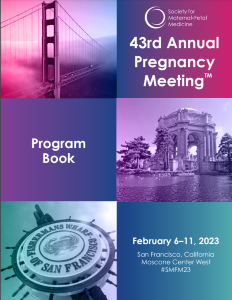Oral Plenary Session II
Oral Plenary Sessions
Livestreamed
15 - Changes in induction of labor and cesarean delivery post ARRIVE trial: A quasi-experimental analysis
The ARRIVE trial, published in Aug 2018, showed elective induction of labor (IOL) for low-risk nulliparas at 39-weeks decreased cesarean delivery (CD). We used interrupted time series (ITS) analysis to assess changes in practice patterns in the US after ARRIVE and any impact on CD or birth after 41-weeks gestation.
Study Design: This study was a population-level ITS analysis using Poisson regression of low-risk nulliparas who delivered at ≥39-weeks gestation using US birth certificate data. Low-risk was defined as singleton, vertex-presenting, non-anomalous births with no chronic hypertension or gestational or pre-gestational diabetes. Aug-Oct 2018 was used as the dissemination period. Monthly rates and temporal trends of 39-week IOL, CD, and ≥41-week delivery before and after the dissemination period were compared between Jan 2016-Mar 2020. Seasonality was accounted for with sine and cosine terms with minimal evidence of residual autocorrelation.
Results:
A total of 2,862,272 births were included (1,829,157 pre-ARRIVE and 1,033,115 post-ARRIVE). In the immediate post-dissemination period, 39-week IOL rates were higher than predicted (15.0% vs 13.7%, IRR 1.096, p< 0.001), ≥41-week delivery rates were lower (14.1% vs. 15.1%, IRR 0.937, p< 0. 001), and CD rates were lower (24.7% vs. 25.1%, IRR 0.984, p< 0. 001). Temporal changes were also noted in the post-dissemination period: an increase of 9/1,000 inductions at 39-weeks per month, decrease of 1.4/1,000 CD per month, and decrease of 8.7/1,000 births at ≥41 weeks per month (p < 0.001 for all) (Figure).
Conclusion:
Publication of the ARRIVE trial was associated with increasing rates of 39-week induction and decreasing rates of CD and ≥41-week delivery in low-risk nulliparas. This builds on prior reports by incorporating more time post-ARRIVE publication, allowing for analysis of changes in trends over time, and by using a robust quasi-experimental methodology, which can overcome limitations of traditional observational studies. These results suggest that the ARRIVE trial findings are generalizable outside of the clinical trial setting.
.jpg)
Rachel L. Wood, MD (she/her/hers)
Maternal Fetal Medicine Fellow
Brigham and Women's Hospital
Boston, Massachusetts, United States
Taylor S. Freret, MD
Massachusetts General Hospital, Department of Obstetrics and Gynecology
Boston, Massachusetts, United States.jpg)
Mark A. Clapp, MD, MPH (he/him/his)
Massachusetts General Hospital, Department of Obstetrics and Gynecology
Boston, Massachusetts, United States.jpeg.jpg)
Sarah E. Little, MD, MPH
Brigham and Women's Hospital
Boston, Massachusetts, United States

.png)
